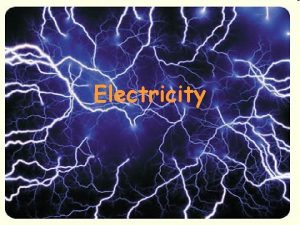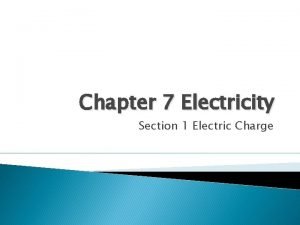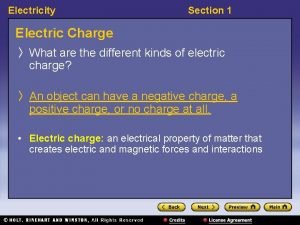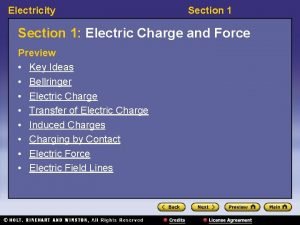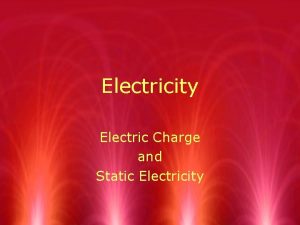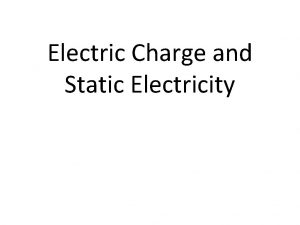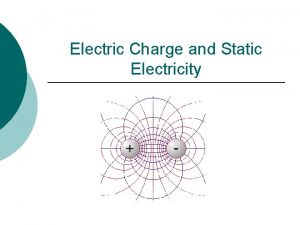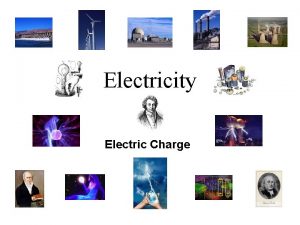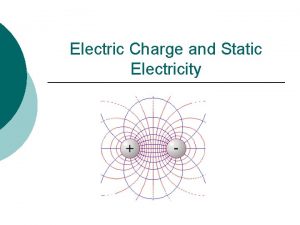Electricity Section 1 Electric Charge What are the












- Slides: 12

Electricity Section 1 Electric Charge 〉 What are the different kinds of electric charge? 〉 An object can have a negative charge, a positive charge, or no charge at all. • Electric charge: an electrical property of matter that creates electric and magnetic forces and interactions

Electricity Section 1 Electric Charge, continued • Like energy, electric charge is never created or destroyed. • Like charges repel, and opposite charges attract. • Electric charge depends on the imbalance of protons and electrons. – Electrons are negatively charged. – Protons are positively charged. – Neutrons are neutral (no charge). – Negatively charged objects have more electrons than protons. – Positively charged objects have fewer electrons than protons.

Electricity Section 1 Transfer of Electric Charge 〉 How do materials become charged when rubbed together? 〉 When different materials are rubbed together, electrons can be transferred from one material to the other. • The direction in which the electrons are transferred depends on the materials.

Electricity Section 1 Transfer of Electric Charge, continued • Conductors allow charges to flow; insulators do not. – electrical conductor: a material in which charges can move freely – electrical insulator: a material in which charges cannot move freely • Charges can move within uncharged objects. – The charges in a neutral conductor can be redistributed without changing the overall charge of the object. – Although the total charge on the conductor will be zero, the opposite sides can have an induced charge.

Electricity Section 1 Induced Charges A negatively charged rod brought near a metal doorknob induces a positive charge on the side of the doorknob closest to the rod and a negative charge on the side farthest from the rod.

Electricity Section 1 Transfer of Electric Charge, continued • Objects can be charged by contact and objects can be charged by friction. – The transfer of electrons from one object to another can charge objects. – Objects charged by touching a charged object to a neutral object are said to be charged by contact. – Charging by friction occurs when one material gains electrons and becomes negatively charged, and the other loses electrons and becomes positively charged. – Your clothes are charged by friction as they rub against each other inside the dryer, and stick together because of static electricity.

Electricity Section 1 Charging by Contact When a negative rod touches a neutral doorknob, electrons move from the rod to the doorknob. The transfer of electrons to the metal doorknob gives the doorknob a net negative charge.

Electricity Section 1 Electric Force 〉 What force is responsible for most everyday forces? 〉 The electric force at the atomic and molecular levels is responsible for most of the everyday forces that we observe, such as the force of a spring and the force of friction. • electric force: the force of attraction or repulsion on a charged particle that is due to an electric field

Electricity Section 1 Electric Force, continued • Electric force acts through a field. – electric field: the space around a charged object in which another charged object experiences an electric force – One way to show an electric field is by drawing electric field lines. – Electric field lines point in the direction of the electric force on a positive charge.

Electricity Section 1 Electric Field Lines The electric field lines around a positive charge point outward. The electric field lines around a negative charge point inward.

Electricity Section 1 Electric Field Lines Two positive charges repel each other. The positive charge is twice as large as the negative charge.

Electricity Section 1 Electric Force, continued • Field lines show both the direction of an electric field and the relative strength due to a given charge. • Electric field lines never cross one another. • The field lines near two like charges point away from each other, and show that the charges repel each other. – More lines are drawn for greater charges to indicate greater force.
 Chapter 6 section 1 electric charge worksheet answers
Chapter 6 section 1 electric charge worksheet answers Section 1 electric charge crossword puzzle answers
Section 1 electric charge crossword puzzle answers Electricity section 1 electric charge
Electricity section 1 electric charge Insidan region jh
Insidan region jh Difference between charge and electric charge
Difference between charge and electric charge Electrons flowing
Electrons flowing Chapter 21 electric charge and electric field
Chapter 21 electric charge and electric field Chapter 21 electric charge and electric field
Chapter 21 electric charge and electric field Coloumb units
Coloumb units Dc o/d per item charge
Dc o/d per item charge Section 1 electric charge crossword puzzle answers
Section 1 electric charge crossword puzzle answers Chapter 17 section 1 electric charge and force answer key
Chapter 17 section 1 electric charge and force answer key Section 1 electric charge
Section 1 electric charge

